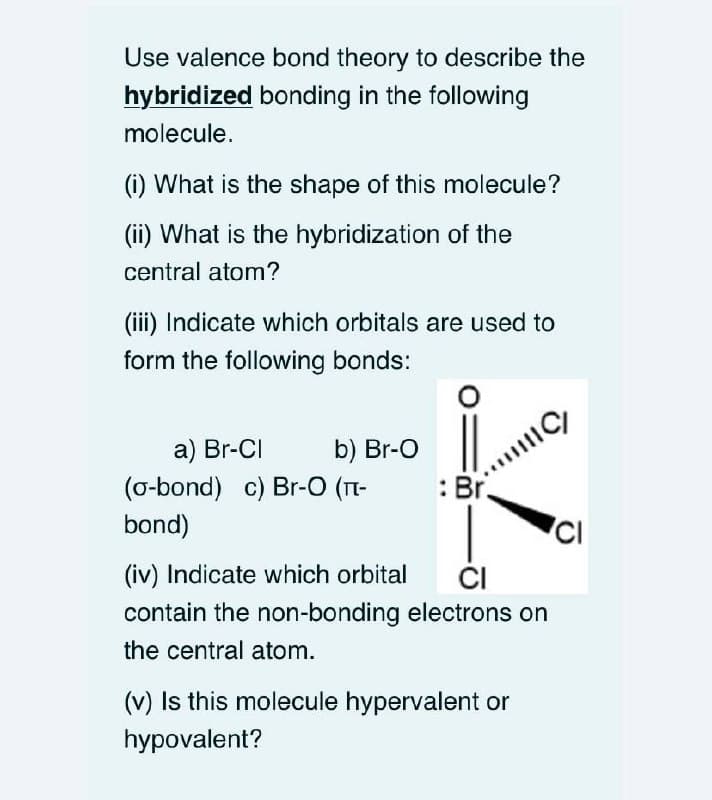Use valence bond theory to describe the hybridized bonding in the following molecule. (i) What is the shape of this molecule? (ii) What is the hybridization of the central atom? (iii) Indicate which orbitals are used to form the following bonds: a) Br-CI b) Br-O : Br. (o-bond) c) Br-O (TT- bond) ČI contain the non-bonding electrons on (iv) Indicate which orbital the central atom. (v) Is this molecule hypervalent or hypovalent?
Use valence bond theory to describe the hybridized bonding in the following molecule. (i) What is the shape of this molecule? (ii) What is the hybridization of the central atom? (iii) Indicate which orbitals are used to form the following bonds: a) Br-CI b) Br-O : Br. (o-bond) c) Br-O (TT- bond) ČI contain the non-bonding electrons on (iv) Indicate which orbital the central atom. (v) Is this molecule hypervalent or hypovalent?
Principles of Modern Chemistry
8th Edition
ISBN:9781305079113
Author:David W. Oxtoby, H. Pat Gillis, Laurie J. Butler
Publisher:David W. Oxtoby, H. Pat Gillis, Laurie J. Butler
Chapter6: Quantum Mechanics And Molecular Structure
Section: Chapter Questions
Problem 65AP: (a) Sketch the occupied MOs of the valence shell for the N2 molecule. Label the orbitals as or ...
Related questions
Question
I need the answer as soon as possible

Transcribed Image Text:Use valence bond theory to describe the
hybridized bonding in the following
molecule.
(i) What is the shape of this molecule?
(ii) What is the hybridization of the
central atom?
(iii) Indicate which orbitals are used to
form the following bonds:
a) Br-CI
b) Br-O
(o-bond) c) Br-O (T-
bond)
: Br.
ČI
contain the non-bonding electrons on
(iv) Indicate which orbital
the central atom.
(v) Is this molecule hypervalent or
hypovalent?
Expert Solution
This question has been solved!
Explore an expertly crafted, step-by-step solution for a thorough understanding of key concepts.
Step by step
Solved in 2 steps with 1 images

Knowledge Booster
Learn more about
Need a deep-dive on the concept behind this application? Look no further. Learn more about this topic, chemistry and related others by exploring similar questions and additional content below.Recommended textbooks for you

Principles of Modern Chemistry
Chemistry
ISBN:
9781305079113
Author:
David W. Oxtoby, H. Pat Gillis, Laurie J. Butler
Publisher:
Cengage Learning

Chemistry: The Molecular Science
Chemistry
ISBN:
9781285199047
Author:
John W. Moore, Conrad L. Stanitski
Publisher:
Cengage Learning

Organic Chemistry: A Guided Inquiry
Chemistry
ISBN:
9780618974122
Author:
Andrei Straumanis
Publisher:
Cengage Learning

Principles of Modern Chemistry
Chemistry
ISBN:
9781305079113
Author:
David W. Oxtoby, H. Pat Gillis, Laurie J. Butler
Publisher:
Cengage Learning

Chemistry: The Molecular Science
Chemistry
ISBN:
9781285199047
Author:
John W. Moore, Conrad L. Stanitski
Publisher:
Cengage Learning

Organic Chemistry: A Guided Inquiry
Chemistry
ISBN:
9780618974122
Author:
Andrei Straumanis
Publisher:
Cengage Learning

Chemistry: Principles and Practice
Chemistry
ISBN:
9780534420123
Author:
Daniel L. Reger, Scott R. Goode, David W. Ball, Edward Mercer
Publisher:
Cengage Learning

Chemistry
Chemistry
ISBN:
9781305957404
Author:
Steven S. Zumdahl, Susan A. Zumdahl, Donald J. DeCoste
Publisher:
Cengage Learning
